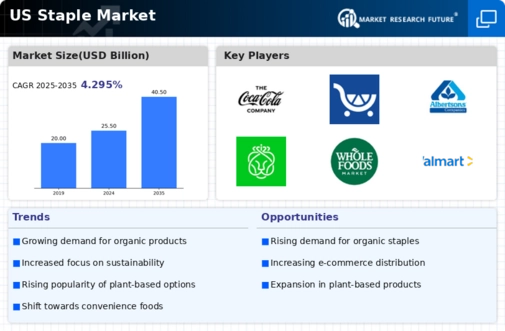The US Staple Market is characterized by a dynamic landscape where key players continuously innovate and adapt to meet consumer demands while facing various competitive pressures. Factors influencing this market include changing consumer preferences towards healthier options, the rise of e-commerce, and the necessity for sustainability in product sourcing and packaging. As staple goods often form the backbone of everyday consumption, companies engaged in this sector are increasingly focusing on strategic partnerships, product diversification, and efficient distribution channels to secure their market presence.
Competition is prominent not only among established brands but also from emerging players aiming to capture market share through unique value propositions and enhanced consumer engagement strategies.CocaCola has cemented its place in the US Staple Market by leveraging its extensive distribution network and brand recognition to deliver a wide array of beverage products that cater to diverse consumer tastes. The company’s strengths lie in its strong marketing capabilities, innovative product development, and an extensive portfolio that includes both traditional and healthier beverage options.
CocaCola's ability to pivot and adapt to market trends, such as the growing demand for low-sugar and functional drinks, ensures that it remains relevant in a competitive landscape. Furthermore, the company's commitment to sustainability initiatives has resonated with environmentally conscious consumers, enhancing its reputation and loyalty in the market. Its strong partnerships with retailers further reinforce CocaCola’s competitive edge, allowing for improved availability and visibility of products in the highly saturated marketplace.Kroger operates as a prominent player in the US Staple Market, known for its extensive grocery store chain that offers a broad selection of food, beverages, and household essentials.
The company excels through its ability to provide personalized shopping experiences and competitive pricing strategies that cater to the diverse needs of its customer base. Primary strengths for Kroger include its comprehensive private label offerings, which allow for greater control over pricing and quality, and its substantial e-commerce presence that has been bolstered through strategic investments in technology and logistics. Kroger’s commitment to enhancing its supply chain efficiency has set it apart, particularly during times of increased demand. The company has also been active in mergers and acquisitions, expanding its footprint in strategic locations and enhancing its product offerings.
Such initiatives contribute to Kroger’s sustained growth and its capability to remain a key player in the evolving US Staple Market. Overall, the company's focus on customer loyalty programs and sustainability further solidifies its competitive positioning.
























Leave a Comment